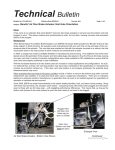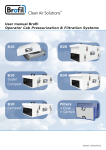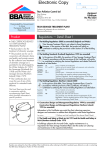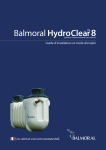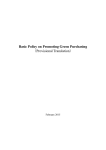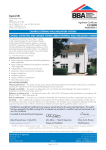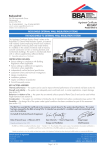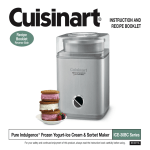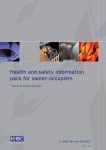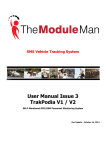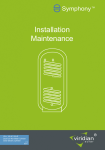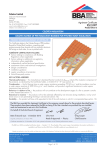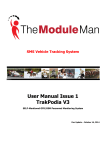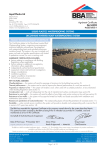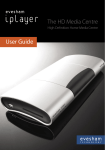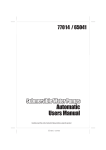Download Electronic Copy - RIBA Product Selector
Transcript
Electronic Copy CI/SfB (5.3) Balmoral Group Ltd Balmoral Park Loirston Aberdeen AB12 3GY Tel: 01224 859100 Fax: 01224 859123 Agrément Certificate No 01/3786 e-mail: [email protected] Designated by Government to issue European Technical Approvals Product • THIS CERTIFICATE RELATES TO THE BALMORAL SBR SEWAGE TREATMENT PLANT. • Each product is for the treatment of domestic sewage. • The products are for use in conjunction with domestic drains and public and private sewers for the collection and treatment of domestic sewage as is permitted to be discharged by the Water Industry Act 1991, the Sewerage (Scotland) Act 1968 and the Water and Sewage Services (Northern Ireland) Order 1973. • This Certificate does not cover the use of any of the products for untreated trade effluents. BALMORAL SBR SEWAGE TREATMENT PLANT Systèmes de traitement des aux résiduaires Abwasseraufbereitung Regulations 1 The Building Regulations 2000 (England and Wales) The Balmoral SBR Sewage Treatment Plant is not subject to these Regulations. However, in the opinion of the BBA, the product will satisfy or contribute to satisfying the provisions under Section 59 of the Building Act 1984. 2 The Building Standards (Scotland) Regulations 1990 (as amended) In the opinion of the BBA, the position of the Balmoral SBR Sewage Treatment Plant, if used in accordance with the provisions of this Certificate, will satisfy or contribute to satisfying the various Regulations and related Technical Standards as listed below. Regulation: Standards: 10 B2.1 and B2.2 The products are acceptable. See section 13 of this Certificate. Comment: Regulation: Standard: Fitness of materials Selection and use of materials and components 24 M2.5 Drainage and sanitary facilities Discharges from a drainage system The products can meet the relevant requirements of this Technical Standard. See sections 8.1 to 8.7 of this Certificate. Comment: 3 The Building Regulations (Northern Ireland) 1994 (as amended) In the opinion of the BBA, the Balmoral SBR Sewage Treatment Plant, if used in accordance with the provisions of this Certificate, will satisfy or contribute to satisfying the various Building Regulations as listed below. Regulation: B2 Regulation: Comment: Fitness of materials and workmanship The products are acceptable. See section 13 of this Certificate. Comment: N9 Cesspools, septic tanks and similar structures The products can meet the relevant requirements of this Regulation. See sections 8.1 to 8.7 of this Certificate. 4 Construction (Design and Management) Regulations 1994 Information in this Certificate may assist the client, planning supervisor, designer and contractors to address their obligations under these Regulations. See section: 2 Delivery and site handling. 5 The Health and Safety at Work etc Act 1974 and the Health and Safety at work (Northern Ireland) Order 1978 In buildings subject to this Act and Order, regular maintenance is a requirement for the Balmoral SBR Sewage Treatment Plant. See the section on Cleaning and maintenance in this Certificate. Readers are advised to check the validity of this Certificate by either referring to the Index of Current BBA Publications or contacting the BBA direct (Telephone Hotline 01923 665400). Technical Specification Electronic6.3 Copy In the RV an air bubble diffuser aerates the liquor for a set period (normally four to six hours). Colonies of bacteria are thus produced which break down and clarify the sewage. 6 Description 6.1 The Balmoral SBR Sewage Treatment Plant (sequential batch reactor) consists of one or two tanks, depending on the size of SBR, which are rotationally moulded in one piece from mediumdensity polyethylene (see Figure 1). The SBR range is shown in Table 1. Figure 1 6.5 The tanks incorporate 110 mm diameter inlet and outlet sockets for connection to 110 mm PVC-U pipework to BS EN 1401-1 : 1998 or the BBA equivalent. Connection to other pipework systems can be made by means of a short length of PVC-U pipe and appropriate adaptors. Balmoral SBR (6 + 12) general layout reactor vessel access desludging access ground level 6.6 The Balmoral rotationally-moulded sampling chamber is installed 2 m downstream on the outlet. This also functions as a rodding/access point. max level batch/cycle volume ⫺ normally 1/3 daily DWF fill max level 6.4 After aeration, a settling period allows the cultured bacteria to settle at the bottom of the RV and the clarified effluent is drawn from the middle of the RV by an air-lift pump. 6.7 The central processing unit which controls the system is housed in a separate control panel kiosk. air-lift pumps out min level in discharge buffer storage of 2/3 daily DWF settled sludge level minimum 12 months reactor vessel activated sludge storage primary settlement (gross solids) bubble diffuser 6.8 Quality control checks during manufacture include: weight of tanks wall thickness material cure position and installation of fittings assembled units receive a final check prior to despatch. min level minimum 12 months sludge storage 7 Delivery and site handling 7.1 The tanks must be handled with care to avoid damage. On delivery and siting, tanks must be lifted using a rope or sling passed through the lifting points provided. The tanks must not be rolled. Site storage should be on level ground. 6.2 In the product, crude sewage enters a large Primary Settlement Tank (PST), this may be a separate tank depending on the model size (see Table 1). The PST has adequate capacity to balance out peak flows and is where the breakdown and storage of solids takes place. From the PST a pre-determined volume of the settled liquor is transferred to the Reactor Vessel (RV) by means of an air-lift pump. Table 1 Treatment plant data Catalogue Population number served Max drain inlet invert depth Head loss through unit (mm) (mm) (mm) 6 1000 30 2060 dia SBR/12 12 1000 30 SBR/18 18 1000 SBR/24 24 SBR/36 SBR/48 SBR/6 7.2 Each tanks bears the manufacturer’s name, identification number and the BBA identification mark incorporating the number of this Certificate. The installation instructions are attached to the tank. Tank dimensions Primary Reactor settlement vessel (mm) Nominal tank volumes Primary Reactor settlement vessel Max desludging interval Vessel weight (litres) (litres) (months) (per unit kg) n/a 2120 2000 12 298 2380 dia n/a 4300 3600 12 405 80 2380 dia 2380 dia 6000 6000 12 283 1000 80 2380 dia 2380 dia 6000 6000 6 285 36 1000 80 2250 dia x 2950 long 2380 dia 8000 6000 6 363 48 1000 80 2250 dia x 2950 long 2250 dia x 2950 long 8000 8000 6 443 2 Design Data ElectronicParticular Copy attention should be given to the provision of concrete backfill to resist flotation due to groundwater. 8 General 9.3 No superimposed loads such as vehicles should be allowed within 3 m of the tanks unless a concrete surround or reinforced concrete slab is designed by a qualified civil/structural engineer so that no loads are transmitted directly on to the tank. 8.1 The Balmoral SBR Sewage Treatment Plant is suitable for the collection and treatment of domestic sewage from households of up to 48 people. The appropriate model for the population should be selected using the details given in Table 1. 10 Resistance to chemicals The product is resistant to the small quantities of acid, alkali or other substances likely to be found in normal domestic sewage or the surrounding backfill. 8.2 The general design of the installation should be in accordance with BS 6297 : 1983. 8.3 The product should be sited as far as possible from domestic dwellings, in accordance with the relevant Building Regulations and BS 6297 : 1983. 11 Watertightness The product, when correctly installed, will not allow seepage either into or from the surrounding soil. The pipe joints, when correctly made, will be watertight. 8.4 Groundwater and flood levels should always be below plant outlet level, unless specific arrangements have been made to overcome this problem. 12 Cleaning and maintenance 12.1 Cleaning and maintenance should be carried out in accordance with the User’s Manual supplied with each unit. When carrying out any work on the product it is important to observe all the Health and Safety warnings in the User’s Manual. 8.5 The discharge from the unit must be to a suitable sub-soil irrigation system or water course in accordance with the requirements of the Environment Agency or the Scottish Environment Protection Agency. 12.2 Desludging is effected by a suction tanker, taking care to avoid damage by the hose nozzle. 8.6 A sampling chamber should be provided at the outlet 2 m downstream to comply with the sampling requirements of the Environment Agency (England and Wales) and the Scottish Environment Protection Agency (Scotland). Frequency of inspection 12.3 Where the system is installed and used in situations subject to The Health and Safety at Work etc Act 1974 and The Health and Safety at Work (Northern Ireland) Order 1978, an inspection of the system must be carried out every 12 months. 8.7 The treated effluent discharging from the product will normally be to Band 2 of Table 10 of BS 7781 : 1994 [ie suspended solids (SS) content <30 mg per litre, Biochemical Oxygen Demand (BOD5) <20 mg per litre], provided the hydraulic and BOD loadings are within the manufacturer’s specifications (see section 8.1). Under certain conditions the effluent may not be within these Standards. This is normal for any biological sewage treatment process and can be caused by unusual hydraulic or BOD loading, weather conditions, contamination by greases, excessive amounts and/or strength of laundry wastewater or poisoning of the microbiological fauna and flora by chemicals or antibiotics. 13 Durability The structural properties of the polyethylene from which the tank is constructed, in common with all similar materials, will deteriorate with time. The deterioration is accelerated by contact with groundwater, sewage and dissolved or suspended organic or inorganic compounds (the resulting loss of strength and stiffness has been taken into account in the manufacturer’s design code). In the opinion of the BBA, the product, when used in the context of and installed in accordance with this Certificate, will have a life in excess of 25 years. The mechanical and electrical components are liable to wear during operation, but the design layout is such that they can be replaced as required. 8.8 Balmoral Group Ltd offer their clients a maintenance service contract for regular inspection and necessary maintenance of the Balmoral SBR units. 9 Strength Installation 9.1 The manufacturer’s design has been assessed as satisfactory. The product has adequate strength to resist damage from minor impacts during handling. It must be slung at the lifting points provided (see section 7.1). 14 General 9.2 The product must be installed in accordance with the Installation Guidelines provided with the units (see section 14 for installation summary). 14.2 Electrical connections to the product from the control panel must be carried out by a competent person using material suitable for the purpose. 14.1 Balmoral Group Ltd can advise clients of the installation requirements. 3 Electronicgravel. Copy As backfilling progresses the tank is filled 14.3 Electrical connections must be in strict accordance with the manufacturer’s instruction and the IEE Wiring Regulations — Regulations for Electrical Installations, Sixteenth Edition 1991. Cables must be protected from accidental damage, eg by a suitable conduit. with water to match the level of backfill. Wet, poorly drained site 15.3 The base of the excavation should allow for between 200 and 250 mm of consolidated hardcore prior to covering with sand blinding and a polythene membrane and a 150 mm depth of concrete. The tank is lowered onto the freshly laid concrete and ‘puddled’ to form a cradle. 14.4 The control panel kiosk can be sited anywhere with access to mains electricity within a 2 m radius of the plant itself. 14.5 The product must not be installed in areas liable to localised flooding without adequate protection as specified by the marketing company. 15.4 The tank is filled with water to a level of 0.5 m and the excavation is backfilled in layers of a lean mix concrete. Concrete is essential as the backfill material where there is a possibility of a high water table of ground water accumulating or where the tank is installed in non-free draining or heavy soil. 14.6 It is essential to take precautions to prevent damage by site traffic. Superimposed loads from vehicles, etc should not be permitted within a distance equal to the depth of excavation, unless suitable structural protection is provided. A fence may be required to prevent vehicles from approaching too close to the unit. Backfilling 15.5 With either installation, as backfilling progresses the tank is filled with water to match the level of backfilling and partly balance the pressure on the tank. Backfilling must be carefully consolidated around the tank to ensure even transfer of soil loads to the tank shell and to prevent localised stress concentrations. The concrete surround must be carefully placed and compacted around the tank. Siting 14.7 The products should be sited so that: • they are not prejudicial to the health of any person • there is an adequate means of access for emptying. 14.8 Installation must be strictly in accordance with the manufacturer’s instructions and the recommendations of BS 6297 : 1983, when applicable. Note: In the six and twelve person models the internal reactor vessel (RV) must be filled to one third of its height with water before the outer primary settlement tank (PST) is filled. 14.9 The excavation for the tank must be carried out generally in accordance with BS 6031 : 1981 paying particular attention to safety procedures and must be of sufficient size to permit easy placement and backfilling. Allowances must be made for any ground support system and the excavation depth must be as specified by the manufacturer for the appropriate size of tank. 15.6 The backfilling surround is brought up to a level 50 mm below the inlet and outlet pipes, any temporary pipe covers are removed and the tank is connected with 110 mm diameter PVC-U pipes or other suitable pipes, using adaptors as necessary. A short length of pipe with flexible joints must be used adjacent to the tank to allow for slight differential movement. A vent pipe should be installed on the outlet pipe (see Figure 2). 14.10 A dry site is defined as one where the water table is always below the bottom of the tank and the subsoil is well drained. A wet site is defined as where the subsoil is of a poor draining nature, eg clay, and therefore susceptible to holding surface water. 15.7 Backfilling is progressed to ground level with backfill material determined by ground conditions (see Figure 2). Installation of control panel kiosk 15.8 A site for the kiosk must be carefully selected within 2 m of the tank and from where the SBR manhole lid can be seen. The ground should be free from flooding and should not restrict access for desludging. 14.11 To maintain the head difference between inlet and outlet connections and in line with the incoming drain the tank must be positioned vertically, on a level foundation. Levelling pegs should not be used under the tank base as damage to the tank may result. A spirit level or surveying level should be used to ensure the correct positioning is achieved. 15.9 A small trench, approximately 450 mm deep by 300 mm wide, must be excavated from the air line outlet point on the SBR to the site of the kiosk. A length of 110 mm diameter PVC-U drain should be laid in the trench (preferably on a gravel bed) and the end inserted into the grommet provided at the SBR. 15 Procedure Dry, well drained site 15.1 A minimum base thickness of 150 mm lean mix concrete (minimum C7.5) to BS 5328-2 : 1997 is required. When laid, the tank is lowered into position. 15.10 A 90° bend should be fitted at the kiosk end and a short length of vertical pipe fitted so that the ducting projects vertically up to the finished ground level. After kiosk installation the pipe should be sealed with expandable foam. 15.2 After the base has initially set, the tank is filled with water to a level of 0.5 m and the excavation is backfilled in layers with graded pea 4 Electronic Copy Figure 2 Installation measure BOD and suspended solids and the results compared to the requirements of BS 7781 : 1994. Technical Investigations The following is a summary of the technical investigations carried out on the Balmoral SBR Sewage Treatment Plant. 17.3 The manufacturing process was examined, including the methods adopted for quality control, and details obtained of the quality and composition of the materials used. 16 Tests 16.1 Tests were carried out on the tank material to determine: density, based on ISO 1183 : Method A : 1987 Vicat softening temperature, BS 2782-1 : Method 120B : 1990 melt flow rate, BS 2782-7 : Method 720A : 1979 17.4 An assessment was made of the tank in relation to: watertightness degredation of mechanical properties resulting from exposure to sewage, groundwater, dissolved salts and dilute acids or alkalis long-term loading conditions compliance with the guidelines given in BS 6297 : 1983 in relation to chamber sizing and constructional details. 16.2 Tests were carried out on complete tanks to determine: capacity resistance to vacuum pressure dimensional accuracy watertightness of connections when subjected to angular deflection effect of long-term exposure to internal pressure. 17.5 Visits were made to sites to assess the practicability and ease of installation. Bibliography 17 Other investigations 17.1 Assessments were made of the structural calculations and assumptions used in the design of the product and of the durability of the tank in relation to chemical attack by effluents and groundwater, and in relation to long-term loading. BS 2782 Methods of testing plastics BS 2782-1 Thermal properties BS 2782-1 : Method 120B : 1990 Determination of Vicat softening temperature of thermoplastics BS 2782-7 Rheological properties BS 2782-7 : Method 720A : 1979 Determination of melt flow rate of thermoplastics 17.2 An examination was made of sample analyses of effluent from the Balmoral SBR, carried out to 5 Electronicin theCopy form in which it was current at the date of BS 5328 Concrete BS 5328-2 : 1997 Methods for specifying concrete mixes BS 6031 : 1981 Code of practice for earthworks BS 6297 : 1983 Code of practice for design and installation of small sewage treatment works and cesspools BS 7781 : 1994 Procedure for type testing of small biological domestic wastewater treatment plants BS EN 1401 Plastics piping systems for nonpressure underground drainage and sewerage. Unplasticized poly(vinylchloride) (PVC-U) BS EN 1401-1 : 1998 Specifications for pipes, fittings and the system ISO 1183 : 1987 Method for determining the density and relative density of non-cellular plastics this Certificate. 18.3 This Certificate will remain valid for an unlimited period provided that the product and the manufacture and/or fabricating process(es) thereof: (a) are maintained at or above the levels which have been assessed and found to be satisfactory by the BBA; (b) continue to be checked by the BBA or its agents; and (c) are reviewed by the BBA as and when it considers appropriate. 18.4 In granting this Certificate, the BBA makes no representation as to: (a) the presence or absence of any patent or similar rights subsisting in the product or any other product; (b) the right of the Certificate holder to market, supply, install or maintain the product; and (c) the nature of individual installations of the product, including methods and workmanship. Conditions of Certification 18 Conditions 18.1 This Certificate: (a) relates only to the product that is described, installed, used and maintained as set out in this Certificate; (b) is granted only to the company, firm or person identified on the front cover — no other company, firm or person may hold or claim any entitlement to this Certificate; (c) has to be read, considered and used as a whole document — it may be misleading and will be incomplete to be selective; (d) is copyright of the BBA. 18.2 References in this Certificate to any Act of Parliament, Regulation made thereunder, Directive or Regulation of the European Union, Statutory Instrument, Code of Practice, British Standard, manufacturers’ instructions or similar publication, shall be construed as references to such publication 18.5 Any recommendations relating to the use or installation of this product which are contained or referred to in this Certificate are the minimum standards required to be met when the product is used. They do not purport in any way to restate the requirements of the Health & Safety at Work etc Act 1974, or of any other statutory, common law or other duty which may exist at the date of this Certificate or in the future; nor is conformity with such recommendations to be taken as satisfying the requirements of the 1974 Act or of any present or future statutory, common law or other duty of care. In granting this Certificate, the BBA does not accept responsibility to any person or body for any loss or damage, including personal injury, arising as a direct or indirect result of the installation and use of this product. In the opinion of the British Board of Agrément, the Balmoral SBR Sewage Treatment Plant is fit for its intended use provided it is installed, used and maintained as set out in this Certificate. Certificate No 01/3786 is accordingly awarded to Balmoral Group Ltd. On behalf of the British Board of Agrément Date of issue: 23rd March 2001 British Board of Agrément P O Box No 195, Bucknalls Lane Garston, Watford, Herts WD25 9BA Fax: 01923 665301 Chief Executive ©2001 e-mail: [email protected] website: www.bbacerts.co.uk For technical or additional information, tel: 01923 665300. For information about Agrément Certificate validity and scope, tel: Hotline: 01923 665400






